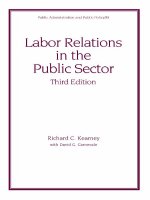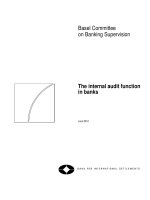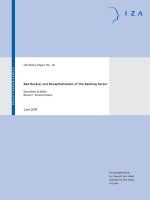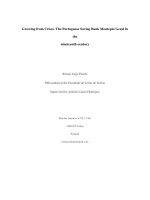Internal Audit Independence in the Public Sector docx
Bạn đang xem bản rút gọn của tài liệu. Xem và tải ngay bản đầy đủ của tài liệu tại đây (244.3 KB, 10 trang )
INTOSAI GOV 9140
The International Standards of Supreme Audit Institutions, ISSAIs, are
issued by the International Organization of Supreme Audit Institutions,
INTOSAI. For more information visit www.issai.org
I N T O S A I
Internal Audit
Independence in the
Public Sector
INTOSAI General Secretariat - RECHNUNGSHOF
(Austrian Court of Audit)
DAMPFSCHIFFSTRASSE 2
A-1033 VIENNA
AUSTRIA
Tel.: ++43 (1) 711 71 • Fax: ++43 (1) 718 09 69
E-MAIL: ;
WORLD WIDE WEB:
I N T O S A I
EXPERIENTIA MUTUA
OMNIBUS
PRODEST
EXPERIENTIA MUTUA
OMNIBUS PRODEST
I NT O SAI P r ofe s si o nal S t an d ar d s C omm it t ee
PSC-Secretariat
Rigsrevisionen • Landgreven 4 • P.O. Box 9009 • 1022 Copenhagen K • Denmark
Tel.:+45 3392 8400 • Fax:+45 3311 0415 •E-mail:
1
1. INTRODUCTION
1.1 This paper on internal audit independence in the public sector addresses concerns
related to independence and objectivity and methods to achieve independence.
1.2 Internal auditing is performed in diverse environments and within organizations
that vary in purpose, size, and structure. In addition, the laws and regulations within
various countries differ from one another. Particularly, public sector auditors operate
in organizational structures that are as complex and varied as the many forms of
government that exist throughout the world today.
1.3 The International Standards of Supreme Audit Institutions (ISSAI) and the
Institute of Internal Auditors’ (the IIA’s) International Standards for the Professional
Practice of Internal Auditing (Standards), present general terms to allow adoption in
different national contexts with the understanding that implementation will be
governed by the environment in which the internal audit activity carries out their
responsibilities and in accordance with the applicable laws and regulations. The IIA’s
Standards are universal and are intended to apply to all members of the internal audit
profession.
1.4 Internal auditing has become a factor of the new accountability and control era.
The manner in which public sector entities maintain internal control and how they are
held accountable has evolved to require more transparency and more accountability
from these organizations that spend investor or taxpayer funds. This trend has
significantly impacted how management implements, monitors, and reports on
internal control.
1.5 Although internal auditors can be a valuable advisory resource on internal control,
the internal auditor should not be a substitute for a strong internal control system. A
system of internal control is the primary response to risks.
1.6 The role of internal auditing has evolved from an administrative procedure with a
focus on compliance, to an important element of good governance. In many cases the
existence of internal auditing is mandatory.
1.7 In describing public sector auditing, the Lima Declaration calls for internal audit
services to be functionally and organizationally independent as far as possible within
their respective constitutional frameworks (ISSAI 1/section 3, par. 2).
1.8 The IIA’s Standards and Code of Ethics recognize the importance of internal
auditors maintaining their independence and objectivity when performing their work,
irrespective of whether the internal auditors are engaged in public or private sector
audits. In addition, the IIA Standards advocate a strong system of internal control
that is monitored by a well-resourced internal audit activity as a fundamental feature
of good governance. In the public sector, a strong system of governance is essential
in ensuring adequate service delivery to the public at large.
2
1.9 For both SAIs and internal auditors, the need for independence and objectivity in
conducting an audit is essential. Internal auditors’ independence and objectivity is an
important factor to enable coordination and cooperation between SAIs and internal
auditors (INTOSAI GOV 9150), including in determining whether and to what extent
SAIs can use the work of internal auditors (ISSAI 1610, ISA 610/par. 9). In this
regard, it is critical that public sector internal audit activities are configured and
positioned appropriately within the organization.
1.10 This paper does not include tools or best practices. They will be made available
on the Subcommittee for Internal Control Standards’ e-platform.
2. THE ROLE OF INTERNAL AUDITING
2.1 IIA defines internal auditing as an independent, objective assurance and
consulting activity designed to add value and improve an organization’s operations. It
helps an organization accomplish its objectives by bringing a systematic, disciplined
approach to evaluate and improve the effectiveness of risk management, control, and
governance processes.
2.2 Internal auditing may analyze strengths and weaknesses of an organization’s
internal control, considering its governance, organizational culture, and related threats
and opportunities for improvement which can affect whether the organization is able
to achieve its goals. The analysis assesses whether risk management identifies the
risks and puts controls in place to manage public funds in an effective and efficient
manner.
2.3 Internal auditing works with those charged with governance,
1
such as board, audit
committee, senior management or, where appropriate, an external oversight body, in
ensuring that appropriate systems of internal control are designed and implemented.
As such, internal auditing can provide assistance regarding accomplishment of goals
and objectives, strengthening controls, and improving the efficiency and effectiveness
of operations and compliance with authorities. It is important to clarify that while
internal auditing can provide assistance on internal control, it should not perform
management or operational duties.
3. PUBLIC SECTOR INTERNAL AUDITING
3.1 As is true for all internal auditors, public sector internal auditors are called upon to
assist organizations in improving their operations. The public sector internal audit
function is an element of a strong public sector governance foundation. Most public
sector internal auditors also play a role in their entity’s accountability to the public as
part of the check-and-balance process.
3.2 The diverse nature of the public sector places increasing importance and value on
a common understanding of independence as it is key to any auditor’s credibility. As
1
Those charged with governance: cf ISSAI 1260.
3
internal auditors are an integral part of the organization, the achievement and
maintenance of independence is even more challenging.
3.3 The internal audit function can be organized and performed at various levels
within an entity, or within a broader framework that covers a set of similar entities.
The same principles and rules apply to these different organizational levels of internal
auditing.
4. MODELS FOR RESOURCING INTERNAL AUDITING
4.1 There are various models for resourcing an internal audit activity. These include:
In-house:
Internal audit services are provided exclusively or predominantly by in-house
employees of the organization. The internal audit activity is managed in-
house by an employee of the organization.
Co-sourced:
Internal audit services are provided by a combination of in-house employees
and service providers. The internal audit activity is managed in-house by an
employee of the organization.
Outsourced with in-house management:
Internal audit services are provided by service providers contracted to the
organization for this purpose. The internal audit activity is managed in-house
by an employee of the organization, and
Fully outsourced.
All internal audit services are provided by service providers contracted to the
organization for this purpose. The service provider also manages the internal
audit activity. Project management of the service provider contract is done in-
house by an employee of the organization.
5. DEFINING INDEPENDENCE AND OBJECTIVITY
5.1 Independence can be generally defined as freedom from dependence on, or
influence or control by, another person, organization, or state. Internal auditors work
for, and primarily report to, the audited entity. For internal auditors, independence is
the freedom from conditions that threaten the ability of the internal audit activity or
the chief audit executive (CAE) to carry out internal audit responsibilities in an
unbiased manner. Independence permits internal auditors to render the impartial and
unbiased judgments essential to the proper conduct of engagements.
5.2.1 Objectivity is defined in the IIA Standards as an unbiased mental attitude that
allows internal auditors to perform engagements in such a manner that they have an
honest belief in their work product and that the quality of their work is not
compromised in any way.
5.2.2 IIA Standards also states that objectivity requires that internal auditors do not
subordinate their judgment on audit matters to others. Threats to objectivity, such as
4
possible conflicts of interests, must be managed at the individual auditor, engagement,
functional, and organizational levels, and disclosed as necessary.
6. WHY INDEPENDENCE AND OBJECTIVITY ARE VITAL
6.1 Whatever the form of government, the need for independence and objectivity in
audit is vital (ISSAI 200/2.3). Independence and objectivity are vital in ensuring that
stakeholders view the audit work performed, and the results, as credible, factual, and
unbiased.
6.2 The nature of internal auditing and the role of providing unbiased and accurate
information on the use of public resources and services delivered require the internal
audit activity to perform their duties without restrictions - free from interference or
pressures from the organization being reviewed or the area under audit.
6.3 Development of sound working relationships with management and staff at all
levels of the organization is fundamental to the effectiveness of the internal audit
function. The internal audit activity’s knowledge and understanding of the
organization assist in building effective relationships and in evaluating and improving
the effectiveness of risk management, internal control, and governance processes.
Ideally, and where appropriate, the organization’s employees should bring concerns,
information, and important matters to the attention of the internal audit activity. In
addition, an effective and well-run audit activity will be sought out for services,
information, and guidance.
6.4 By providing unbiased, objective assessments of whether public sector operations
and resources are responsibly and effectively managed to achieve intended results, the
auditor can help the public sector organization achieve accountability and integrity,
improve operations, and instill confidence among citizens and stakeholders.
7. INDEPENDENCE AND OBJECTIVITY CRITERIA
7.1 ISSAI 1610 seeks to assess whether the environment in which internal auditing
operates allows the internal auditor to be sufficiently autonomous and objective to the
extent that the external auditor can use the work of the internal auditor. This is
equivalent to the assessment of internal audit independence within INTOSAI GOV
9140.
7.2 In addition to the criteria in ISA 610, ISSAI 1610 provides criteria to assess the
objectivity of the internal audit function in the public sector. The internal audit
function:
Is established by legislation or regulation;
Is accountable to top management, for example the head or deputy head of the
government entity, and to those charged with governance;
Reports the audit results both to top management, for example the head or
deputy head of the government entity, and those charged with governance;
5
Is located organizationally outside the staff and management function of the
unit under audit;
Is sufficiently removed from political pressure to conduct audits and report
findings, opinions, and conclusions objectively without fear of political
reprisal;
Does not permit internal audit staff to audit operations for which they have
previously been responsible for to avoid any perceived conflict of interest; and
Has access to those charged with governance.
7.3 Additionally, criteria to assess the independence of the internal audit function in
the public sector may include:
Clear and formally defined responsibilities and authorities of internal auditing
in an audit charter;
Functional and personal segregation of internal auditing from responsibilities
for management tasks and decisions (e.g. as heads of operational working
groups in administrative reform projects);
Adequate freedom for the CAE in establishing audit plans;
Adequate payment and grading within the salary scale according to the
responsibility and significance of internal auditing; and
Involvement and participation of the CAE in recruitment of audit staff.
7.4 Also the IIA Standards requires, and leading practices dictate, that the internal
audit activity is independent, and that internal auditors are objective in performing
their work. To achieve the degree of independence necessary to effectively carry out
the responsibilities of the internal audit activity, the head of the internal audit activity
has direct and unrestricted access to those charged with governance. Independence is
achieved through organizational status and objectivity (IPPF 1100-1130 Independence
and Objectivity).
7.5 Under IIA Standards the CAE must report to a level within the organization that
allows the internal audit activity to fulfill its responsibilities. The CAE must confirm
to those charged with governance, at least annually, the organizational independence
of the internal audit activity. According to the IIA Practice Advisory 1111-1 the CAE
must communicate and interact directly with the board. Direct communication occurs
when the CAE regularly attends and participates in board meetings that relate to the
board’s oversight responsibilities for auditing, financial reporting, organizational
governance, and control. Such communication and interaction also occurs when the
CAE meets with the board, at least annually. The internal audit activity must be free
from interference in determining the scope of internal auditing, performing work, and
communicating results.
8. CONCERNS RELATED TO INDEPENDENCE AND OBJECTIVITY
8.1 An internal auditor occupies a unique position within an organization. The
auditor is employed by the organization but is also expected to review the conduct of
operations. This has a potential to create significant tension since the internal
auditor's “independence” from management is necessary for the auditor to objectively
assess management’s actions.
6
8.2 Internal auditing’s in-depth knowledge and understanding of operational
conditions of the audited entity can add significant value to the organization.
However, it may be hindered in upholding the public trust if measures to protect its
independence are not developed, implemented, and maintained. These measures
include provisions to ensure that the internal audit activity is empowered to report
significant issues to those charged with governance; is supported by management
formally and in practice; and is provided with sufficient resources to effectively
perform its duties.
8.3 The appearance or perception of a lack of independence and objectivity could be
as damaging as the actual condition. If internal auditors are involved in developing
the internal control systems, it may become difficult to maintain the appearance of
independence when auditing these systems.
9. HOW TO ACHIEVE INDEPENDENCE AND OBJECTIVITY
9.1 Clearly, independence and objectivity are key elements of an effective public
sector internal audit activity. To comply with the independence and objectivity
criteria mentioned above several measures may be considered. Recommended
measures are:
9.2 Appropriate Placement and Organizational Status
9.2.1 The ability to achieve internal audit activity independence and objectivity is
contingent on the appropriate placement and/or organizational status of the internal
audit activity within the organization.
9.2.2 The organizational status of the internal audit activity should be sufficient to
allow it to accomplish its activities as defined by its audit charter. The audit activity
must be positioned in such a way that it may obtain cooperation from management
and staff of the program or entity being audited, and have free, unrestricted access to
all functions, records, property, and personnel – including those charged with
governance.
9.2.3 Where practicable, those charged with governance (oversight body) should
exercise discretion and at least be consulted regarding the appointment, removal, and
compensation considerations of the CAE. Consideration may also be given to
appointing an appropriately organized, independent body to appoint the CAE.
9.2.4 The CAE should be equal in rank to senior management of the organization. To
avoid possible conflicts of interest, the CAE should report to a level in the
organization that would allow the internal audit activity to effectively carry out its
responsibility.
9.2.5 The CAE should have direct communication with those charged with
governance. This communication reinforces the organizational status of internal
auditing, enables full support and unrestricted access to functions, records, property,
7
and personnel, and helps ensure that there is no impairment to independence. This
provides sufficient authority to ensure broad audit coverage, adequate consideration
of engagement communications, and appropriate action on recommendations.
9.3 Reporting Relationship
9.3.1 Under IIA Standards the CAE must report to a level within the organization that
allows the internal audit activity to fulfill its responsibilities.
9.3.2 The CAE should report to executive management for assistance in establishing
direction, support, and administrative interface; and to those charged with governance
for strategic direction, reinforcement, and accountability. Those charged with
governance (e.g. the audit committee) should safeguard the independence by
approving the internal audit charter and (where applicable) the mandate.
9.3.3 The IIA Standards requires, and other guidance strongly recommend, that to
help maintain the independence of the internal audit activity, its personnel should
report to the CAE, who reports administratively to the chief executive officer or
equivalent and functionally to those charged with governance.
9.4 Competency
9.4.1 The IIA’s Code of Ethics requires, and leading practices dictate, that internal
auditors engage in those services for which they have the necessary knowledge, skills,
and experience; perform duties in accordance with the Standards; and continually
improve their proficiency and effectiveness. The Standards requires that internal
auditors, and the internal audit activity collectively possess or develop the knowledge,
skills, and other competencies needed to perform their responsibilities. Competent
and professional internal audit staff, in particular those that adhere to the Standards,
can help ensure the internal audit activity’s success.
9.5 Legislative Requirements
9.5.1 Legislative requirements to establish an internal audit activity help protect the
funding and independence of the internal audit activity and recognize internal audit as
an important function in the public sector. Finally, adequate legal protection of
internal auditor independence, in particular under civil service law, is an important
element of a legislative framework.
8
REFERENCES
INTOSAI
- ISSAI 1 The Lima Declaration, Section 3. Internal audit and external audit
- ISSAI 200 General standards in Government Auditing and standards with
ethical significance
- ISSAI 1260 Communication with those Charged with Governance
- ISSAI 1610 Financial Audit Guideline – Special Considerations – Using the
Work of Internal Auditors
- INTOSAI GOV 9100 Guidelines for Internal Control Standards for the Public
Sector
- INTOSAI GOV 9150 Coordination and Cooperation between SAIs and
Internal Auditors in the Public Sector
IFAC
- International Standard on Auditing 610
- Governance in the Public Sector: A Governing Body Perspective, 2001
IIA
- The International Professional Practices Framework, including the Definition
of Internal Auditing, the Code of Ethics, The International Standards for the
Professional Practice of Internal Auditing (Standards), Practice Advisories,
Position Papers and Practice Guides
- The Role of Auditing in Public Sector Governance, 2006
Independence and Objectivity: A Framework for Internal Auditors, 2001, American
Accounting Association, IIA Research Foundation
Internal Auditing: Assurance & Consulting Services, 2009, IIA Research Foundation
Internal Auditing in the Public Sector, Gansburghe, Internal Auditor Magazine,
August 2005
Internal Audit Trends in the Public Sector, Sterck and Bouckaert, Internal Auditor
Magazine, August 2006
20 Questions Directors Should Ask About Internal Audit, 2004, Fraser & Lindsay,
The Canadian Institute of Chartered Accountants
Best Practices and tools will be integrated in the e-platform









